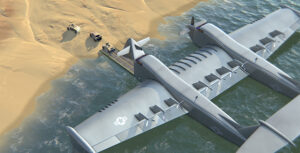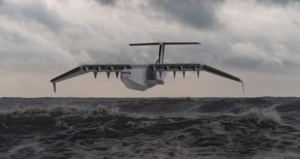The Defense Advanced Research Projects Agency (DARPA) selected teams led by General Atomics and Boeing’s [BA] Aurora Flight Sciences to develop designs for the Liberty Lifter Seaplane full-scale demonstrator, the agency said Wednesday.
This program seeks to demonstrate an improvement in operational capability by designing, building, floating and flying a long-range, low-cost X-Plane capable of strategic and tactical heavy lift.
General Atomics Aeronautical Systems (GA-ASI) is set to work with the Maritime Applied Physics Corporation while Aurora will work with Leidos’ [LDOS] Gibbs & Cox and ReconCraft.

DARPA said the Liberty Lifter demonstrator will be a flying boat with a size and capacity similar to the Boeing C-17 Globemaster III. According to an Air Force fact sheet, the Globemaster III is 174 feet long, has a wingspan of over 169 feet, has a maximum payload capacity of 170,900 pounds, and has a cruise speed of about 450 knots.
DARPA first unveiled the Liberty Lifter project concept last May. At the time, the agency said it was aiming to combine fast and flexible strategic lift of large and heavy loads with the ability to take-off and land on water, with controlled flight close to turbulent water. It was also billed as being built with a low-cost design and construction philosophy (Defense Daily, May 27).
The agency now elaborated its goals for this X-Plane is takeoff and landing on the water in Sea State 4, sustained on-water operations up to Sea State 5 and extended flight “close to the water in ground effect” with a capability to fly out of ground effect at altitudes up to 10,000 feet above sea level.
In Phase 1 DARPA is working with the two teams to refine their designs, focusing on operational needs and concepts. The initial Phase I contract covers an 18-month period of performance with six months of conceptual design work and nine months of design maturation leading to a preliminary design review (PDR). This is followed by a three-month period for manufacturing planning and test/demonstration planning reviews.
The program is set to transition into Phase 2 in mid-2024 focusing on continued detailed design, manufacturing and demonstration of the full-scale Liberty Lifter plane.
DARPA said it expects to team with one or more of the services and international partners for Phase 2 activities and further development of the concept into an operational vehicle.
“We are excited to kick off this program and looking forward to working closely with both performer teams as they mature their point-of-departure design concepts through Phase 1. “The two teams have taken distinctly different design approaches that will enable us to explore a relatively large design space during Phase 1,” DARPA Liberty Lifter Program Manager Christopher Kent said in a statement.
The two teams are indeed taking drastically different approaches to the seaplane.
The GA team is using a twin-hull mid-wing design meant to optimize on-water stability and seakeeping. DARPA noted it uses distributed propulsion via 12 turboshaft engines.
GA said the program calls for the aircraft to operate efficiently at under 100 feet above the ground, hold altitudes up to 10,000 feet and transport “huge payloads at speeds faster than current sea lift platforms, while shifting the paradigm of strategic lift to a cost per ton instead of cost per pound approach.”
DoD first announced General Atomics Aeronautical Systems Inc. won an $8 million contract for this Liberty Lifter program in November. The announcement said the company would perform the work in Poway, Calif., and is expected to be finished by May 2023.

GA-ASI said the initial award covers the first six month base effort with an option to extend it for another 12 months, covering the 18-month period of performance in Phase 1. If DARPA exercises the option for GA-ASI, the total contract would rise to $29 million total.
“GA-ASI is committed to the advancement of a cargo seaplane design capable of delivering heavy cargo and utilizing Wing-in-Ground effect to revolutionize transport to support tomorrow’s warfighter,” GA-ASI president David Alexander said in a statement.
Alexander argued the company’s experience with other maritime aircraft like the MQ-9B SkyGuardian and SeaGuardian will help them progress the capabilities and they see this as a way to expand their cargo aircraft portfolio.
In contrast, the Aurora-led design uses a more traditional flying boat style with a single hull, high wing and with turboprop engines. The company noted DARPA’s specifications includes a ferry range of over 6,500 nautical miles and a cargo capacity of two Marine Corps Amphibious Combat Vehicles or six 20-foot container units.
Aurora’s concept “will employ a robust and adaptive control system designed to meet the challenge of operations to and from the sea surface and at low altitude around waves and obstacles,” the company said in a statement.
The company said early test structures for its version of the Liberty Lifter will be fabricated at unspecified shipyards in the Pacific Northwest region and it is eyeing flight testing occurring in about five years.
“Developing an X-plane requiring innovative solutions and complex controls is at the core of Aurora’s expertise. We look forward to solving this challenge and providing a new strategic capability to support tomorrow’s warfighter,” Graham Drozeski, vice president of government programs at Aurora Flight Sciences, said in a statement.